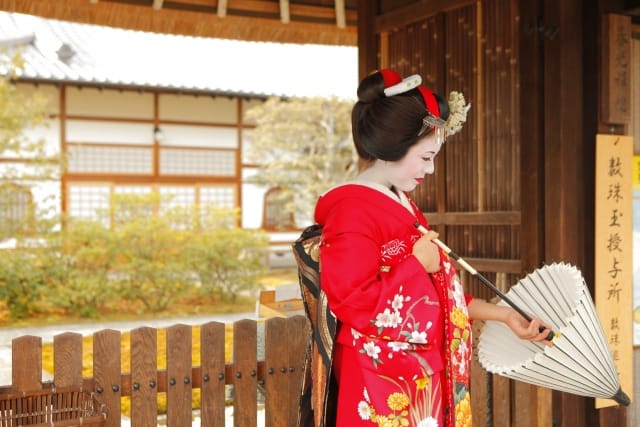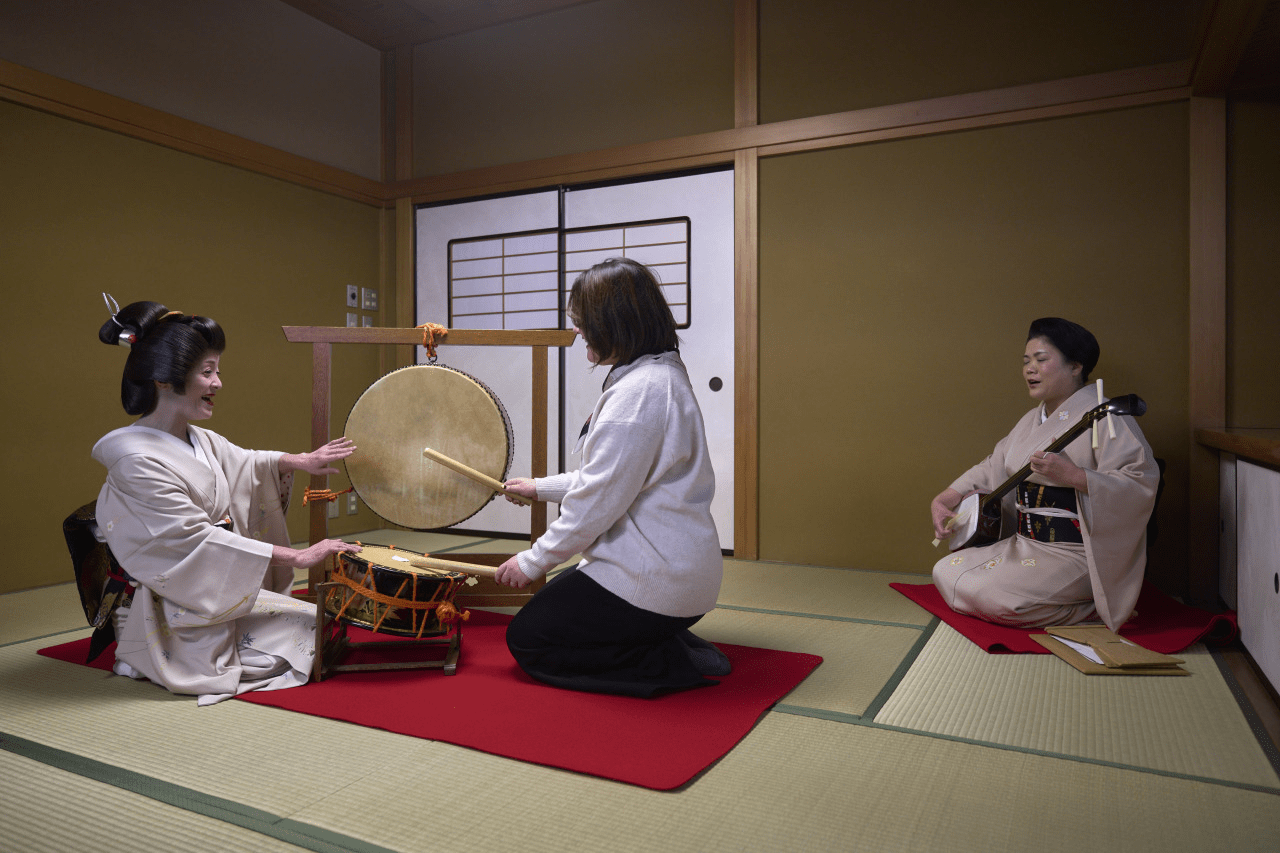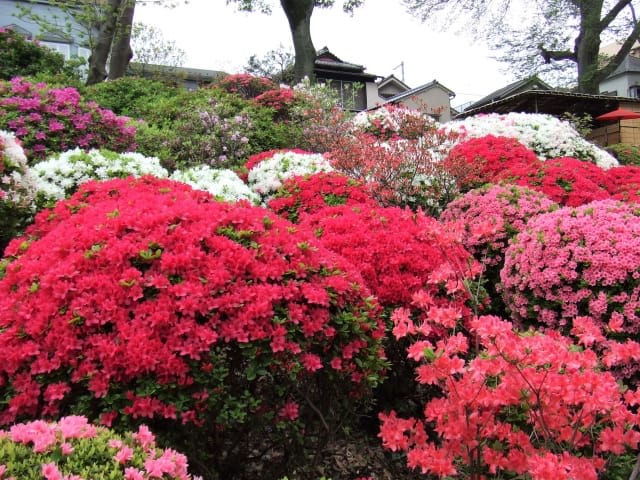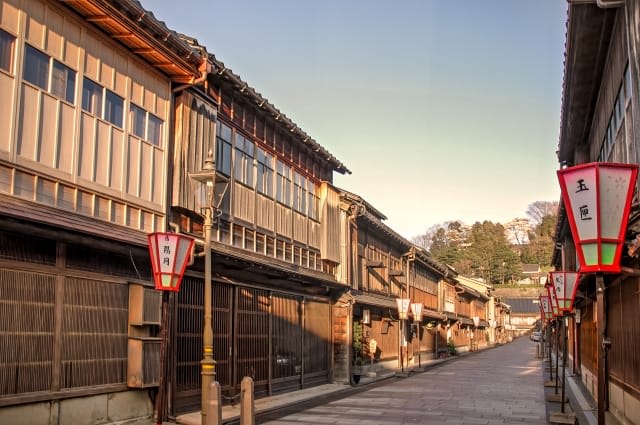Kanazawa Geiko (Geisha) Experience: Difference Between Maiko & Best Event List w/Map
Kanazawa is a beautiful city where old townscapes and traditional culture still remain. In the Chaya District, restaurants and teahouses line the streets with traditional lattice doors, and the atmosphere of the old-fashioned geisha district still lives on today. An indispensable presence there is the Geiko.
Geiko are figures who symbolize Kanazawa's culture, inheriting traditional Japanese performing arts and entertaining guests with dance and shamisen.
This article introduces what Geiko are, where you can actually encounter them, and special events taking place in 2025.

Table of Contents
-Kanazawa Geiko / Maiko Difference
-3 Areas Where You Can Meet Geiko in Kanazawa
-In 2025, You're Lucky—Events Where You Can Meet Geiko Are Being Held!
What is Geiko?
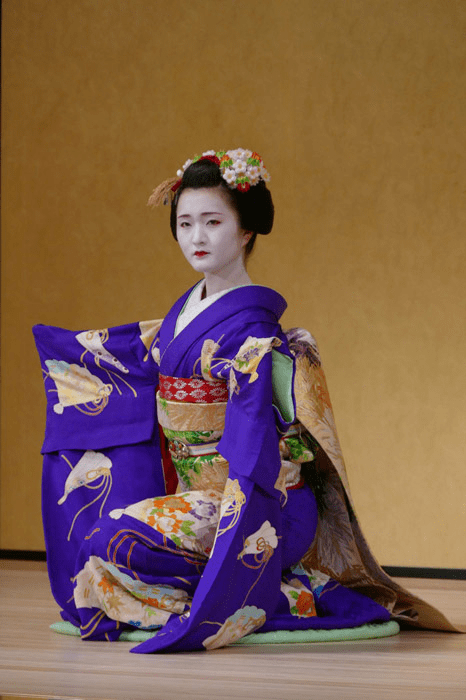
Geiko are women who specialize in traditional Japanese performing arts. They enliven banquets and entertain guests while showcasing artistic performances such as dance, singing, and shamisen.
Geiko are not merely entertainers, but important figures who preserve regional culture and tradition.
Incidentally, Geiko are called different names in different regions of Japan. In Tokyo and other areas, they are called "Geisha," in Kyoto they are called "Geiko," and in Kanazawa they are called "Geigi."
For clarity, this article uses the term "Geiko," but please remember that when you visit Kanazawa, they are referred to as "Geigi."
Geiko are figures that symbolize Japanese aesthetics and the spirit of hospitality.
Why Does Kanazawa Have Geiko?

The reason why Kanazawa Geiko still remain today is related to the city's historical background.
From the 17th to 19th centuries, Japan entered an era called the Edo period.
At that time, the city was governed by the Maeda clan, who were daimyo (feudal lords in the Edo period).
They actively protected culture and the arts, promoting the city's development. As part of this effort, they also established "Chaya Districts" where Geiko could work safely.
Another important reason is that Kanazawa was not destroyed in major wars.
Therefore, old buildings and beautiful townscapes remained intact, and the tradition of performing arts has continued uninterrupted to this day.
Kanazawa Geiko exist inseparably from the city's history and townscape, continuing to preserve regional culture.
Kanazawa Geiko / Maiko Difference
Geiko and Maiko are often confused, but they are actually different entities.
Maiko are apprentice Geiko who exist only in Kyoto, representing the stage where young women undergo training.
Geiko, on the other hand, are professionals in the arts who have completed their training and become independent. They have acquired a wide range of skills including dance, shamisen, singing, and customer service, and are figures who grace Ozashiki (banquet rooms) with a mature and calm atmosphere.
In fact, Maiko do not exist in Kanazawa. However, by comparing the geisha district cultures of Kyoto and Kanazawa, you can better understand the characteristics of each.
What Exactly is a Maiko?
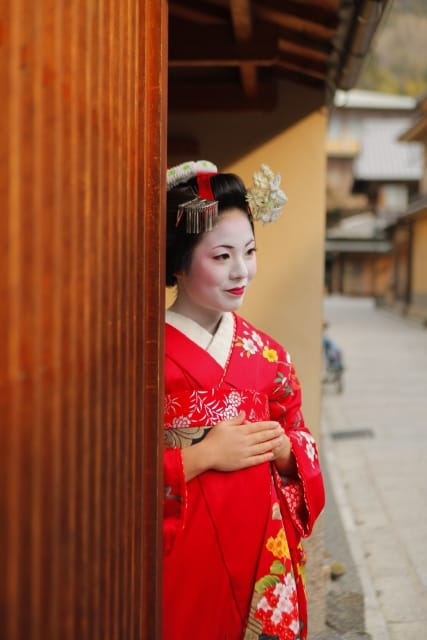
Maiko is a term unique to Kyoto that refers to young girls training to become full-fledged Geiko.
From around ages 15 to 20, they diligently practice dance and shamisen while gaining practical experience at ozashiki (banquet settings).
They are characterized by youthful, lovely, and gorgeous attire including white face makeup, the "darari obi" (long obi that reaches the ground), and "hana kanzashi" (seasonal flower hairpins that adorn their hair).
At banquets, they perform dances to entertain guests and learn the spirit of hospitality from the behavior of senior Geiko. After completing this training period, they finally become independent as Geiko.
In Kyoto, it is common to become a Geiko after serving as a Maiko, but in Kanazawa, women start their careers directly as Geiko.
Difference 1: Job Content and Capabilities

Geiko are accomplished entertainers. They have mastered all the arts, including dance, music, and conversation skills.
They excel at flexible hospitality tailored to their guests and are reliable figures who skillfully lead the entire banquet.
In contrast, Maiko are still in training, and the arts they can perform are limited.
Their main role is to enliven the atmosphere with youthful and graceful dances. Their earnest efforts to learn etiquette while supporting senior Geiko overflow with fresh charm.
Guests feel the joy of "supporting their growth" through witnessing such devoted Maiko.
Difference 2: Hairstyle and Makeup
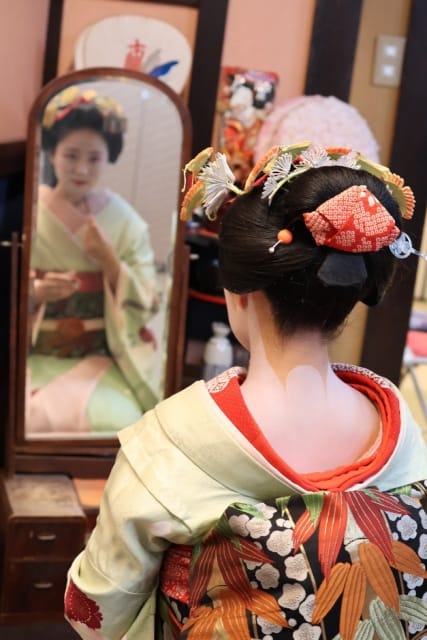
Maiko's makeup involves painting the entire face white with powder and using rouge partially to emphasize youthfulness and freshness. By applying light rouge to the eyes and cheeks, they create a graceful and youthful impression.
Their hairstyle is characterized by styling their own hair and attaching seasonal ornaments such as hana kanzashi, which represents both splendor and their stage of development.
On the other hand, Geiko's makeup is more subdued and emphasizes natural beauty.
Their hairstyle uses a wig rather than their own hair and is neatly arranged, with a style that emphasizes dignity over ornateness.
Difference 3: Kimono Colors and Patterns
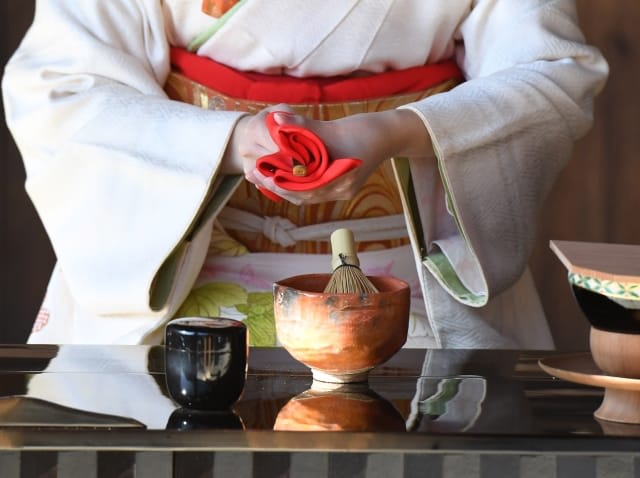
Maiko wear kimono with bright, flashy colors and bold patterns. The Maiko's obi (traditional sash belt for kimono) is called "darari obi" and is characterized by hanging down long in the back.
Furthermore, because they wear thick-soled "okobo (high wooden clogs worn by maiko)," even their walking appearance looks gorgeous. All of these are attire meant to emphasize youthfulness and freshness.
In contrast, Geiko choose calm color tones with elegant and modest patterns. Their obi is also shorter, creating an overall refined and mature atmosphere.
Their footwear also lacks the height of Maiko's and uses items that give a more subdued impression.
From their kimono attire, you can see that Maiko represent splendor while Geiko represent mature dignity.
Difference 4: Residence and Living Arrangements

Maiko live communally in lodgings called "okiya" with fellow apprentices and seniors also in training.
Here, all food, clothing, and shelter are provided, and daily life and practice proceed in an inseparable manner.
They learn not only dance and shamisen techniques but also etiquette, ways of speaking, and deportment directly from seniors and the okiya's okami (female manager of an okiya or ryotei). Daily life itself becomes part of their training.
Upon becoming Geiko, they leave the okiya and establish their own residence to live independently. While managing their own living expenses and work schedules, they visit ryotei and teahouses to perform their arts.
3 Areas Where You Can Meet Geiko in Kanazawa
Kanazawa has three representative Chaya Districts.
Higashi Chaya District is gorgeous and popular with tourists, while Nishi Chaya District, though small-scale, is charming with its calm atmosphere.
Kazue Machi Chaya District has beautiful night views along the river, offering a magical experience.
You can experience different Geiko culture in each area.
Higashi Chaya District
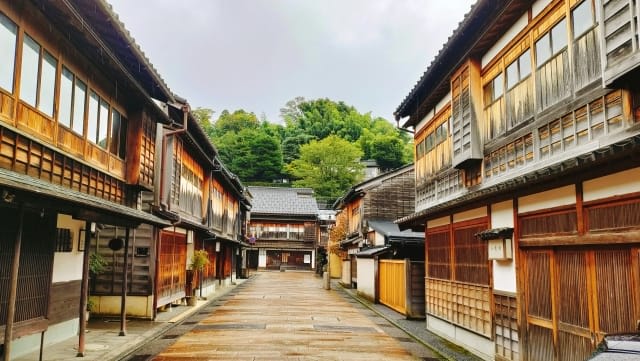
Higashi Chaya District is Kanazawa's largest Chaya District, where townscapes from the Edo period (1603–1868) are preserved.
It is a gorgeous area visited by many tourists and is designated as an Important Preservation District for Groups of Traditional Buildings.
Event and Facility Information:
-Event: "Geisha Evenings"
-Venue: Kaikaro Teahouse
-Activities: Building tours and Geiko dance performances
-Language: English explanations available
-Ideal for: Foreign tourists and first-time visitors to Kanazawa
Because you can experience both tourism and traditional culture, this is the most recommended area for travelers visiting Kanazawa for the first time.
Nishi Chaya District
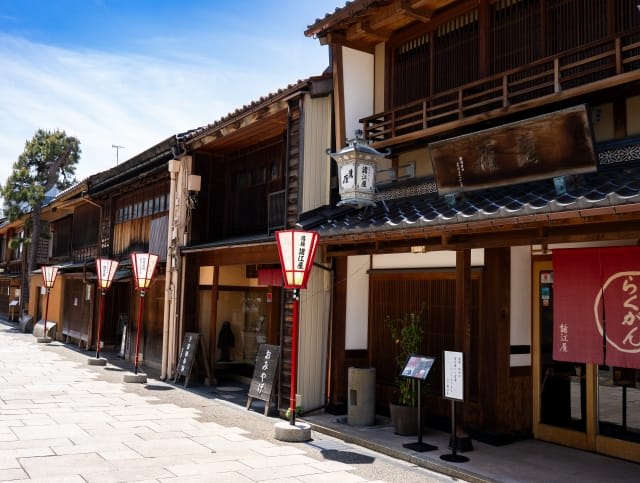
Nishi Chaya District is characterized by its smaller scale and calm atmosphere. Unlike Higashi Chaya District, which attracts many tourists, Nishi Chaya District has less foot traffic and allows for quiet strolling.
At the center of Nishi Chaya District is the Nishi Kenban Office, which serves as a training and coordination center for Geiko. Since the Nishi Kenban Office is still an active base where Kanazawa Geiko polish their artistic skills, if you're lucky, you may hear the sound of shamisen practice.
In summer, events such as the "Summer Evening Geiko Performance" are held, where you can watch Geiko dances up close.
This district is recommended for those seeking a refined cultural experience rather than glamorous entertainment. For those who want to feel the world of Kanazawa Geiko in a quiet setting, Nishi Chaya District is perfect.
<Information>
-Schedule: April 26, 2025 - March 28, 2026, 13:00-14:00
(held on designated Saturdays during the period)
(excluding July, August, and year-end/New Year holidays)
-Access: Get off at Hashiba-cho (Higashi/Kazue-machi Chaya District) or Higashiyama 3-chome → 5-minute walk → Higashi Chaya District
-Admission: General 5,000 yen, University students and under 2,500 yen (preschool children not permitted)
-Website: https://www.kanazawa-kankoukyoukai.or.jp/article/detail_26.html
Kazue Machi Chaya District
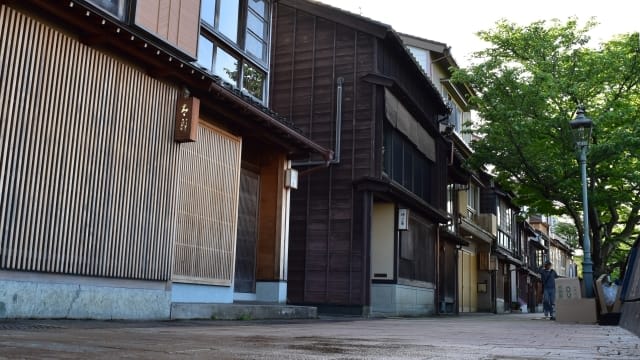
Kazue Machi Chaya District is an atmospheric area that spreads along the Asano River.
The charm of this district lies in its historical streetscape, represented by winding alleys and Kuragari-zaka Slope. One distinctive feature is how the atmosphere changes dramatically depending on the time of day you visit.
In this beautiful setting, events such as the "Official Kanazawa Geiko Experience" are sometimes held.
At these events, you can casually enjoy Geiko dances and Ozashiki Asobi that are not usually accessible to the public.
This area is recommended for those who want to create unforgettable memories while enjoying the beautiful night views.
To Deeply Enjoy the Historic Tea House Districts, Tour with Explanations from a Local Guide!

For those who want to thoroughly learn about Kanazawa's history and culture, we recommend a tour with a local guide.
This tour allows you to explore Omicho Market, which has over 300 years of history, and experience Kanazawa's food culture while sampling Kaga vegetables and fresh seafood.
Additionally, you can visit Kenrokuen Garden, one of the Three Great Gardens of Japan, and learn about the beautiful scenery that changes with each season and the history of the Maeda clan.
At Higashi Chaya District, you can enjoy matcha and traditional Japanese sweets at a traditional tea house that has been operating for over 200 years while learning about the background of Geiko culture and understanding the Kanazawa Geiko / Maiko difference—how Kanazawa Geiko maintain their independent artistic traditions distinct from Kyoto's Maiko system.
The guide provides English support and assists with photography and introducing hidden gems, making your trip even more special.
However, since there is a considerable walking distance, we recommend participating in comfortable shoes.
<Information>
Meeting point: FamilyMart+Drug Komeya Kanazawa Musashi Store
Tour area: Kanazawa Castle Park・Kenrokuen Garden・Higashi Chaya District
Start time: 10:00
In 2025, You're Lucky—Events Where You Can Meet Geiko Are Being Held!
Source:Official website
In 2025, special events are being held in Kanazawa where you can meet Geiko directly.
The most notable is the "Official Kanazawa Geiko Experience."
At this special event, you can watch elegant dances by Kanazawa Geiko and the powerful "Ozashiki Taiko" performance right before your eyes.
You can also experience Ozashiki Asobi with guidance from Geiko. Ozashiki Asobi refers to traditional, simple games that Geiko and guests play together at banquets to enliven the atmosphere.
One of the great attractions is the opportunity to speak directly with Geiko in a friendly atmosphere.
This is a precious opportunity to experience the world of Kanazawa Geiko, which is usually difficult to access. Please consider participating.
Note: As a rule of Japanese culture, you cannot enter the ozashiki barefoot. Please be sure to wear socks.
<Information>
Period: April 26, 2025 – March 28, 2026 (designated Saturdays excluding July and August)
Time: 13:00–14:00
Fee: General 5,000 yen, University students and under 2,500 yen
In Kyoto, There Are Also Activities Where You Can Enjoy Dinner and Ozashiki Asobi with Maiko!
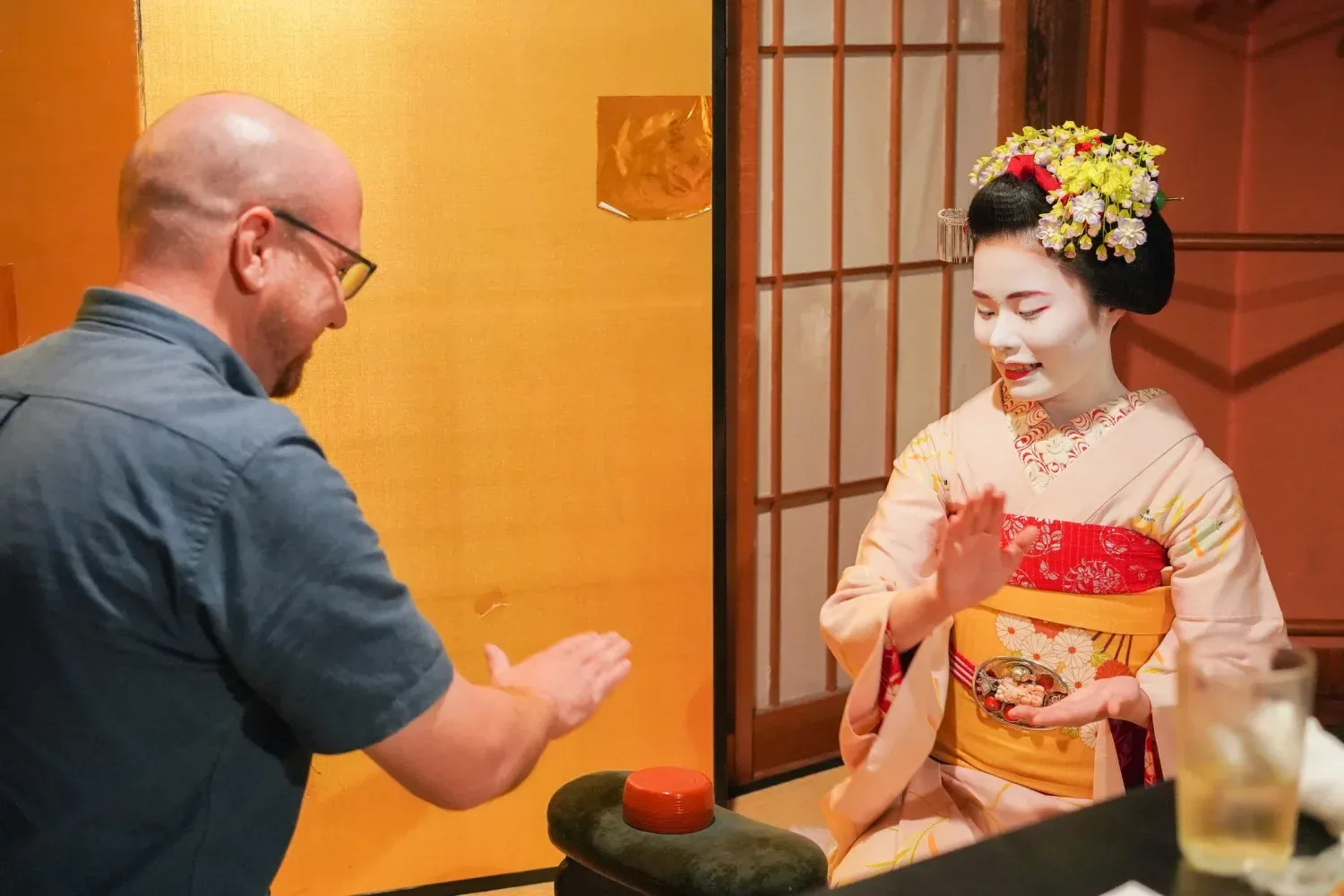
If you want to meet Maiko, visit Kyoto and participate in a tour where you can meet Maiko.
The greatest appeal of this tour is the opportunity to directly interact with Maiko, whom you cannot usually meet.
Like Kanazawa Geiko, Maiko can usually only be met by a limited number of people. However, by participating in this tour, even tourists can safely enjoy interacting with Maiko.
This experience highlights the Kanazawa Geiko / Maiko difference—while both are traditional entertainers, Kanazawa Geiko are independent professionals, whereas Kyoto Maiko are apprentices training to become full Geiko.
First, stroll through the Gion district with a local guide and learn about Maiko culture and history.
After the walk, savor traditional Kyoto cuisine at a traditional machiya restaurant while waiting for the Maiko's appearance. When the Maiko appears, the atmosphere becomes instantly vibrant.
Participants are captivated by the elegant dances and light conversation, feeling as if they've been invited to a special banquet.
Enjoy the highlight of your trip by playing Ozashiki Asobi with the Maiko, engaging in conversation, and taking commemorative photos.
This experience will surely remain in your heart as an unforgettable memory of your Japan trip.
<Information>
Meeting point: In front of Izumo no Okuni Statue, right outside of Exit 5 of Gion Shijo Station (Keihan Line)
Tour area: Gion
Start time: 18:30
